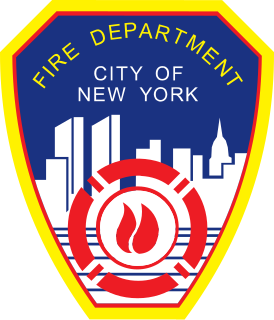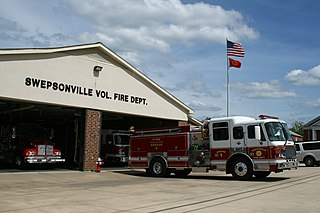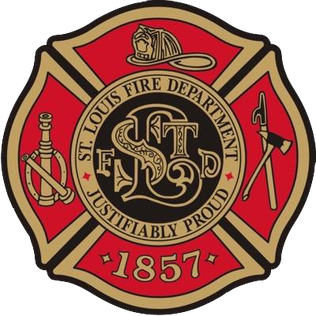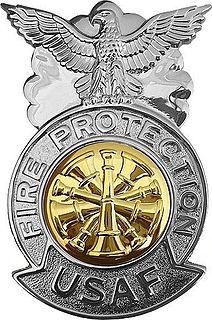
A firefighter is a rescuer extensively trained in firefighting, primarily to extinguish hazardous fires that threaten life, property, and the environment as well as to rescue people and in some cases or jurisdictions also animals from dangerous situations. Male firefighters are sometimes referred to as firemen.

The New York City Fire Department, officially the Fire Department of the City of New York (FDNY), is an American department of the government of New York City that provides fire protection, technical rescue services, primary response to biological, chemical, and radioactive hazards, and emergency medical services responses to the five boroughs of New York City.

A volunteer fire department (VFD) is a fire department of volunteers who perform fire suppression and other related emergency services for a local jurisdiction. Volunteer and retained (on-call) firefighters are expected to be on call to respond to emergency calls for long periods of time, and are summoned to the fire station when their services are needed. They are also expected to attend other non-emergency duties as well.

The Chicago Fire Department (CFD) provides fire suppression, rescue services, Hazardous Materials Response services and emergency medical response services to the city of Chicago, Illinois, United States, under the jurisdiction of the Mayor of Chicago. The Chicago Fire Department is the second largest municipal fire department in the United States after the New York City Fire Department (FDNY). It is also one of the oldest major organized fire departments in the nation.
Firefighting jargon includes a diverse lexicon of both common and idiosyncratic terms. One problem that exists in trying to create a list such as this is that much of the terminology used by a particular department is specifically defined in their particular standing operating procedures, such that two departments may have completely different terms for the same thing. For example, depending on whom one asks, a safety team may be referred to as a standby, a RIT or RIG or RIC, or a FAST. Furthermore, a department may change a definition within its SOP, such that one year it may be RIT, and the next RIG or RIC.

A rescue vehicle is a specialised vehicle used in technical rescue. It is designed to transport and provide the specialized equipment necessary for technical rescue. They carry an array of special equipment such as the jaws of life, wooden cribbing, generators, winches, hi-lift jacks, cranes, cutting torches, circular saws and other forms of heavy equipment unavailable on standard trucks. This capability differentiates them from traditional pumper trucks or ladder trucks designed primarily to carry firefighters and their entry gear as well as on-board water tanks, hoses and equipment for fire extinguishing and light rescue. Most rescue vehicles lack on-board water tanks and pumping gear, owing to their specialized role. A rescue vehicle is typically operated by a rescue squad, but in some areas it may be integrated with emergency medical services or fire departments.
In American law enforcement, the Emergency Service Unit, or ESU, is a multi-faceted element within a law enforcement agency’s Special Operations Command.

The Fire and Rescue Department of Malaysia, commonly known as Bomba, is a federal agency of Malaysia responsible for firefighting and technical rescue. Bomba is a Malay word derived from the Portuguese bombeiros which means 'firefighters'.

Palm Beach County Fire Rescue is one of the largest fire departments in the State of Florida. Palm Beach County Fire Rescue provides full time paid cross trained professional firefighter-EMT’s, or firefighter paramedics to provide, fire protection, Advanced Life Support emergency medical services, technical rescue, hazardous materials mitigation, aircraft rescue and firefighting, fire investigation, and 911 dispatching for unincorporated parts of Palm Beach County, Florida and 19 cities under contract.

The Israel Fire and Rescue Services is the national Israeli fire and rescue organization. The organisation also provides rescue services from terror attacks, car accident and dangerous substance spillages, along with Magen David Adom, the National EMS. They are also involved in public education and awareness campaigns. The service is accessed by calling 102 from any phone. As of 2022, the director of the services is Eyal Casspi.

The St. Louis Fire Department provides emergency medical services, fire cause determination, fire prevention, fire suppression, hazardous materials mitigation, and rescue services to the city of St. Louis, Missouri. The department is also the Second oldest paid fire department in the United States. The STLFD is responsible for 69.0 square miles (179 km2) and has a population of approximately 294,890 with a daytime population of over 2 million.

Firefighting in the United States dates back to the earliest European colonies in the Americas. Early firefighters were simply community members who would respond to neighborhood fires with buckets. The first dedicated volunteer fire brigade was established in 1736 in Philadelphia. These volunteer companies were often paid by insurance companies in return for protecting their clients.

The Baltimore City Fire Department (BCFD) provides fire protection and emergency medical services to the city of Baltimore, Maryland, United States. Founded in 1797 and established in 1859, the Baltimore City Fire Department covers an area of 81 square miles (210 km2) of land and 11 square miles (28 km2) of water, with a resident population of over 640,000 and a daytime population of over 1,000,000. The BCFD responds to approximately 235,000 emergency calls annually. There are two International Association of Fire Fighters (IAFF) locals; IAFF 734 for firefighters and IAFF 964 for officers.
The New York City Fire Department Bureau of Emergency Medical Services is a division of the New York City Fire Department (FDNY) in charge of emergency medical services for New York City. It was established on March 17, 1996, following the merger of the FDNY and New York City Health and Hospitals Corporation's emergency medical services division. FDNY EMS provides coverage of all five boroughs of New York City with ambulances and a variety of specialized response vehicles.

New York City Fire Department Rescue Company 1, also known as Rescue 1, is one of five special operations rescue companies of the New York City Fire Department (FDNY) that responds to rescue operations that require specialized equipment and training. It was organized on March 8, 1915.

A hazardous material (hazmat) apparatus is a vehicle used by emergency services to respond to calls involving potentially hazardous materials. These vehicles are customized to fit the needs of the agency responsible for the apparatus, which may be a rescue squad, fire department, emergency medical services, law enforcement agency, or military.
The Lexington Fire Department provides fire prevention, firefighting, emergency medical services, technical rescue, hazardous materials, aircraft firefighting, and dive rescue operations to the 324,604 people who live in the 284 square miles of Fayette County, Kentucky. All of LFD's firefighters are at least EMTs, and more than 220 of them are Paramedics.

Harrisburg Bureau of Fire (HBF) is a firefighting agency that is located in and serves Harrisburg, Pennsylvania, and its surrounding metropolitan area. It is a career firefighting agency with at least 15 firefighters and fire officers on duty at any given time, supplemented with volunteer staffing as well. Everyday duties for the Bureau include fire suppression, emergency medical services, tactical rescue, urban search and rescue, water rescue, hazardous materials response, fire prevention, fire codes enforcement, and public safety educations.

The United States Air Force Fire Protection career specialty is the military's premiere specialty in fire protection. Much like their civilian counterparts, these military firefighters protect people, property, and the environment from fires and disasters. They provide firefighting, specialized rescue, HazMat responses, as well as provide fire prevention and response to weapons of mass destruction. Though every branch has its own fire protection career specialties, they all must graduate from the Air Force's 13.5 week fire academy in San Angelo, Texas before being awarded their Firefighter certification.

















